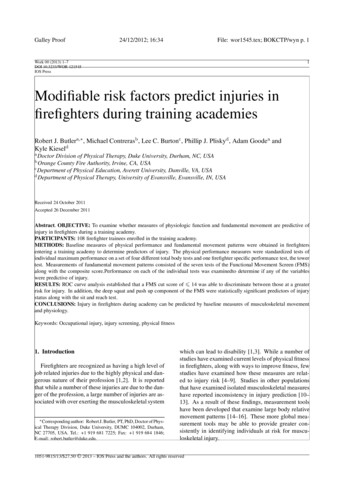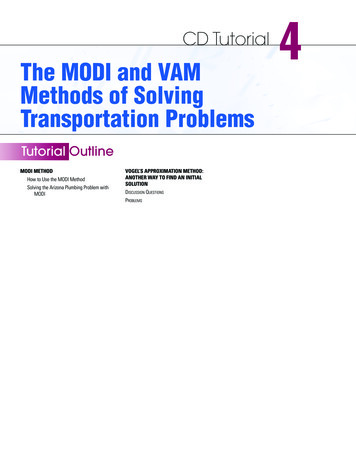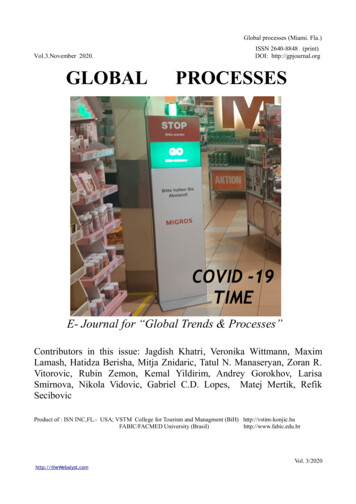
Transcription
Galley Proof24/12/2012; 16:34File: wor1545.tex; BOKCTP/wyn p. 11Work 00 (2013) 1–7DOI 10.3233/WOR-121545IOS PressModifiable risk factors predict injuries infirefighters during training academiesRobert J. Butlera, , Michael Contrerasb , Lee C. Burtonc , Phillip J. Pliskyd , Adam Goodea andKyle KieseldDoctor Division of Physical Therapy, Duke University, Durham, NC, USAOrange County Fire Authority, Irvine, CA, USAcDepartment of Physical Education, Averett University, Danville, VA, USAdDepartment of Physical Therapy, University of Evansville, Evansville, IN, USAabReceived 24 October 2011Accepted 26 December 2011Abstract. OBJECTIVE: To examine whether measures of physiologic function and fundamental movement are predictive ofinjury in firefighters during a training academy.PARTICIPANTS: 108 firefighter trainees enrolled in the training academy.METHODS: Baseline measures of physical performance and fundamental movement patterns were obtained in firefightersentering a training academy to determine predictors of injury. The physical performance measures were standardized tests ofindividual maximum performance on a set of four different total body tests and one firefighter specific performance test, the towertest. Measurements of fundamental movement patterns consisted of the seven tests of the Functional Movement Screen (FMS)along with the composite score.Performance on each of the individual tests was examinedto determine if any of the variableswere predictive of injury.RESULTS: ROC curve analysis established that a FMS cut score of 14 was able to discriminate between those at a greaterrisk for injury. In addition, the deep squat and push up component of the FMS were statistically significant predictors of injurystatus along with the sit and reach test.CONCLUSIONS: Injury in firefighters during academy can be predicted by baseline measures of musculoskeletal movementand physiology.Keywords: Occupational injury, injury screening, physical fitness1. IntroductionFirefighters are recognized as having a high level ofjob related injuries due to the highly physical and dangerous nature of their profession [1,2]. It is reportedthat while a number of these injuries are due to the danger of the profession, a large number of injuries are associated with over exerting the musculoskeletal system Corresponding author:Robert J. Butler, PT, PhD, Doctor of Physical Therapy Division, Duke University, DUMC 104002, Durham,NC 27705, USA. Tel.: 1 919 681 7225; Fax: 1 919 684 1846;E-mail: robert.butler@duke.edu.which can lead to disability [1,3]. While a number ofstudies have examined current levels of physical fitnessin firefighters, along with ways to improve fitness, fewstudies have examined how these measures are related to injury risk [4–9]. Studies in other populationsthat have examined isolated musculoskeletal measureshave reported inconsistency in injury prediction [10–13]. As a result of these findings, measurement toolshave been developed that examine large body relativemovement patterns [14–16]. These more global measurement tools may be able to provide greater consistently in identifying individuals at risk for musculoskeletal injury.1051-9815/13/ 27.50 2013 – IOS Press and the authors. All rights reserved
Galley Proof224/12/2012; 16:34File: wor1545.tex; BOKCTP/wyn p. 2R.J. Butler et al. / Modifiable risk factors predict injuries in firefighters during training academiesFig. 1. Examples of the ending position to score a 2 on each of the tests of the Functional Movement Screen. (Colours are visible in the onlineversion of the article; http://dx.doi.org/10.3233/WOR-121545)One test that examines total body movement patternsis the functional movement screen [17]. The Functional Movement Screen (FMS) consists of 7 tests based onneurodevelopmental milestones and the screen is ableto be reliably completed with a standardized kit in anyenvironment with trained raters (Fig. 1) [18]. The 7tests of the FMS are the deep squat, hurdle step, inline lunge, shoulder mobility, active straight leg raise,trunk stability push up and rotary stability. As a result,the FMS can have implications for the musculoskeletalscreening of individuals in a field setting. The composite score of the FMS (sum of the 7 tests) has been successful in prospectively identifying professional football players and soldiers who are at an elevated riskfor injury ( 14 composite FMS score), as well asidentifying firefighters who had sustained during theprevious year (3 points lower on the FMS compositescore) [19–21]. Multiple studies have supported thatthe composite score of the FMS is able to be modifiedwith an appropriate physical training program [22–24].Interestingly, one factor that was associated with notbeing able to improve an individual’s composite scoreabove the injury cut point was a low initial score on thedeep squat [24]. Currently, there are no published reports of the diagnostic ability of the FMS in predictinginjuries in firefighters.The focus on the role of firefighters has placed alarge amount of research on improving physical fitnessin firefighters [4–9]. However, isolated limitations instrength and fitness have yet to be associated with injury risk in firefighters. Previous research studies havesuccessfully utilized the FMS to identify individualswith an elevated risk of sustaining an injury that limitednormal participation in professions with high physicaldemand [19,20]. Thus, the purposed of this study wasto examine if the FMS is a successful predictor of injury in firefighter trainees. We also wanted to examineif any of the baseline tests on the FMS were associatedwith injury over the course of the Academy training. Inaddition, we also wanted to examine whether standardmeasures of performance in firefighters had a significant relationship with injury status. It was expectedthat the firefighters with lower performance on the FMStests and who exhibited a low composite score wouldbe at a greater risk of being injured. If this findingholds true, these data could be used to develop injuryprevention strategies for firefighter applicants to optimize firefighter health and minimize health care costsfor the fire departments.2. Methods2.1. ParticipantsParticipants in the study were firefighters enrolledin four successive firefighter academies for the Orange County Fire Authority. All subjects enrolled in the
Galley Proof24/12/2012; 16:34File: wor1545.tex; BOKCTP/wyn p. 3R.J. Butler et al. / Modifiable risk factors predict injuries in firefighters during training academiesstudy were currently free from any injury that wouldrestrict active firefighter participation. In order to beenrolled in the academy all firefighters had to clear aphysician administered physical. A total of 108 firefighters were enrolled and tracked for injuries over thecourse of the academy. All subject data was placedinto an electronic medical record. The data that werecollected for the purposes of this study were then deidentified prior to being sent to the research team foranalysis.In an attempt to identify meaningful measures forinjury prediction, baseline measures of physical performance and fundamental movement, FMS,were obtained. The physical performance measures were standardized tests of individual maximum performance ona set of four different total body testsand one firefighter specific performance test, the tower test. Measurements of fundamentalmovementpatterns consisted ofthe seven subtests of the FMS along with the compositescore.2.2. Physical performance testsMeasures of general physiologic function includedthe sit and reach, push up, pull up, 1.5 mile run, as wellas a firefighter specific “tower test”. These tests weretraditionally implemented at the baseline screening ofall firefighter trainees who were entering the academy.2.2.1. Sit and reach testThe sit and reach test was conducted in a standardmanner with a sit and reach box (Acuflex I, Novel Products, Inc, Rockton, IL, USA). The box incorporated areach indicator at a standardized height that provideda measurement of how far each individual was able toreach forward in a long sitting position with their kneesstraight. Subjects were required to maintain controlledflexion in a long sitting position as they reached forward with overlaying left and right hands. The subjects were instructed to slowly exhale as they flexedforward and were instructed to only move the measurement device with their middle fingers. Each subjectwas provided three trials separated by thirty seconds.Any trial where the subjects bounced, flexed the knees,or used momentum to move the device was not counted. The maximum value achieved (cm) was utilized forthe analysis.2.2.2. Pushup testPushups were assessed by examining the number ofpushups that each subject could complete in 2 minutes.Subjects were forced to conduct the push up along with3the beat of a metronome set at 40 beats per minute. Tobe recorded as a full push up each subjects chin hadto make contact with a 5 inch prop placed under thesubjects chin at the end of the down phase and thenhad to achieve full elbow extension at the end of the upphase. The test was stopped if the subject a) reached80 pushups, b) performed three consecutive incorrectpushups or c) did not maintain continuous motion withthe metronome. The maximum number of pushupscompleted during the test was utilized for the analysis.2.2.3. Pull up testPull ups were examined by having the trainee perform a series of standard pull ups while hanging froma pull-up bar. Subjects were able to complete the pullups until failure. All subjects started from a down position and were asked to pull their body up until theirchin was above the bottom of the bar. Subjects wererequired to keep their body and legs still during the testand subjects were required to extend their arms fully atthe end of each repetition.2.3. 1.5 mile runThe 1.5 mile run was conducted as the time eachsubject took to cover the distance on a standard course.Subjects were instructed to cover the distance as quickly as possible but were asked to slow their pace if theyexperienced any pain, severe shortness of breath or other abnormal signs. The time to complete the 1.5 milerun was analyzed for the scope of this study.2.3.1. Tower testThe tower test is a firefighter specific test that is completed in a standardized manner that induces physiologic stress during tasks that are common to firefighters. The tower test begins with a five-story climb that isfollowed by a two story descent. After the two story descent, each subject then performed 20 slam balls (combination of Squat and Downward medicine ball throw)followed by an additional one story descent where thesubject then lowered a 25-pound bundle with a 50-footrope section. The subject then performed a 150-footrun, 20 wall balls (combination of Squat and Upwardmedicine ball throw), 15 pull ups, a 200 foot run and a400-foot hose pull. The time to complete the test wasrecorded to assess the firefighter specific fitness levelsof the firefighters.2.3.2. Fundamental movement pattern testFundamental movement patterns were examined byutilizing the FMS. The FMS testing kit (Fig. 1, Func-
Galley Proof424/12/2012; 16:34File: wor1545.tex; BOKCTP/wyn p. 4R.J. Butler et al. / Modifiable risk factors predict injuries in firefighters during training academiestional Movement Systems, Chatham, VA) is a portableway to reliably and objectively assess seven differenttotal body movement patterns [15–18]. The movementpatterns that are assessed in the FMS are the deep squat,hurdle step, in line lunge, push up, rotary stability, active straight leg raise and shoulder mobility. All movement patterns are carried out and scored in a consistent pattern. Scoring of the 21 point FMS consists ofa score on each of the seven tests ranging from 0–3.For the tests where a bilateral component exists, thelowest score bilaterally is utilized for the calculationof the composite score as well as for the score on thetest. A score of 3 on any of the tests suggests that themovement was completed fully and free from compensation. A score of 2 on the tests suggests that the movement was completely performed but compensation hadto occur in order for the movement to be completed.A score of 1 indicates that the subject was unable tocomplete the movement pattern even in the presence ofcompensation. Scores ranging from 1–3 indicate painfree movement patterns. If the subject was painful during the movement pattern a score of 0 was recorded.In addition to the subtests there were also three clearing tests to assess pain. The clearing tests were theimpingement sign, prone press up, and kneeling flexion. If any of the clearing tests were positive a scoreof 0 was recorded for shoulder mobility, push up orrotary stability, respectively.For the prediction modeleach individualtest score on the FMS was utilized. Thecomposite score on the FMS, sum of each of the testscores, was utilized to identify a cut point that targetsindividuals at an elevated injury risk.2.4. Injury surveillanceOver the course of the 16 week academy all firefighters were tracked for injuries. An injury was defined byany episode that caused the recruit to miss 3 consecutivedays of training in the academy due to musculoskeletalpain (excluding burns). Injuries were tracked by thestrength and conditioning staff of the Orange CountyFire Authority. Presence of any injury over the courseof the academy was scored dichotomously as positiveor negative.2.5. Statistical analysisStatistical analysis was conducted to determinewhich of the performance test and fundamental movement variables were predictive of injury over the courseof the academy. In addition, a cut point was establishedFig. 2. Differences (Mean SEM) in the injured and non-injuredfirefighter recruits for the physical performance tests.using the composite FMS to assist in identifying firefighters at an elevated risk of injury similar to what hasbeen performed in other populations. Injury predictionmodels were run for the physiological variables andmusculoskeletal movement variables separately usingforward and backward logistic regression. Variableswere kept in the model for the forward regression if thep value of each variable was 0.05 while a p value of 0.10 was utilized to include variables in the backwards regression model. In order to determine the cutpoint for the composite FMS score, a receiver operatorcharacteristic (ROC) curve was developed and the pointwas chosen that maximized the correct prediction ofinjury classification based on the FMS score.Standarddiagnostic measures were calculated based on the established cut point of the composite FMS score. Statistical analysis for the regression model an analysisof differences was carried out utilizing SPSS software(version 17, Chicago, IL) while the ROC curve and thestandard diagnostic calculations were calculated usingStata (version 10, College Station, TX).3. ResultsBoth physiologic and fundamental movement variables collected at baseline were significant predictors ofinjury over the course of the academy. The only physiologic variable that was predictive of injury was the sitand reach test (Fig. 2, OR: 1.24 ([95% CI: 1.06–1.42],β 0.218, r 0.218). Two of the musculoskeletalmovement variables were predictive of injury. Boththe deep squat (OR: 1.21 [95% CI: 1.01–1.42], β 0.190) and push up (OR: 1.30 [95% CI: 1.07–1.53],
Galley Proof24/12/2012; 16:34File: wor1545.tex; BOKCTP/wyn p. 5R.J. Butler et al. / Modifiable risk factors predict injuries in firefighters during training academies5Table 1Specificity and sensitivity for composite FMS score across different cut pointsCut off 12 13 14 15 16 .234.562.175.982.889.7Fig. 3. Differences (Mean SEM) in the injured and non-injuredfirefighter recruits on the Functional Movement Screen tests (RS rotary stability, PU trunk stability push up, ASL active straightleg raise, SM shoulder mobility, ILL In line lunge, HS hurdlestep, DS deep squat).β 0.266) were variables that were statistically significant in predicting injury classification (Fig. 3, r 0.330).A cut point of 14 out of 21 was identified to dichotomize those at a greater risk for developing an injury (Table 1). Standard diagnostic testing calculationsresulted in this value exhibiting a Sensitivity of 0.83,Specificity of 0.62, Positive Predictive value of 85.7%,and Negative Predictive value of 58.1% with 77.8% ofthe population correctly classified at this value. At thiscutpoint, the diagnostic odds ratio revealed a value of8.31 (95% CI: 3.2–21.6) and corresponding likelihoodratios ( LR 2.20 and LR 0.26).4. DiscussionFirefighters have a significant incidence of occupation related injury in comparison with other professions [1,2]. A large amount of research has focused onthe physical fitness of physical fitness; however, littleresearch has focused on how the movement profile ofa firefighter is relatedto injury risk [4–9,21]. PreviousCorrectly classified75.976.977.866.760.942.6LR 1.181.412.202.622.272.44LR 0.150.220.260.480.730.83studies have assessed total body movement patterns andhave related the quality of those movement patterns toinjury risk; however this has not been performed in firefighters [19,20]. The results of this study suggest thatmusculoskeletal movement patterns, along with the sitand reach test, are predictive of injury in firefightersgoing through a training academy. In addition, firefighters who scored 14 on the FMS composite had agreater likelihood of sustaining an injury.Previous research on modifiable movement basedinjury risk factors for firefighters is limited. The resultsof this study suggest that performance on the sit andreach, along with deep squat and push up on the FMS,are related to injury risk.Interestingly, all of these factors have been documented as modifiable in previousresearch studies. It was surprising to observe that thesit and reach was a significant predictor of injury; however the active straight leg raise of the FMS was not. Itmay be that the combined flexion of the hip and spine,which includes the obstacle of trunk girth, during thesit and reach performed in long sitting may provide adifferent construct of testing in comparison with the active straight leg raise which is tested in supine and primarily screens for hip mobility, hip and core stability.It is worthy to note that the last FMS variable that wasremoved from the equation in the logistic regressionwas the active straight leg raise.Performance on the sit and reach test has been associated with injury in non-firefighterpopulations [25].Specifically, the sit and reach test has previously beenreported to be related to injury in distance runners [25].However, this study was not prospective in nature. Regardless, it appears that flexibility as determined by thesit and reach may be an important factor to normalize prior to participating in a high demanding physicalactivity such as firefighting. Previous research in firefighters has observed that a 6 week fitness program isable to improve hamstring flexibility [5]. To date no research has examined the effect of improving hamstringflexibility on musculoskeletal injuries in firefighters. Itmay be appropriate for firefighters to be screened onthe sit and reach test prior to entering the academy in
Galley Proof624/12/2012; 16:34File: wor1545.tex; BOKCTP/wyn p. 6R.J. Butler et al. / Modifiable risk factors predict injuries in firefighters during training academiesorder to reduce their risk for injury. In addition, forfirefighters trainees who scored poorly on the sit andreach test it would likely be important for these individuals to continue with a maintenance program duringthe academy to maintain the improvementson the sitand reach test.Another movement pattern that was related to an elevated injury risk in the firefighter was the deep squat.Rhea et al. [26] observed that endurance performanceon the squat was moderately correlated with job performance in firefighters. Based on this one study, itappears that the deep squat is a potentially meaningfulcomponent of the firefighting profession.Previous research on the FMS has suggested that the deep squatis an integral part of correcting total body movementpatterns [24]. This may be due to the fact that the deepsquat, as scored by the FMS, involves upper extremityas well as the traditionally thought of lower extremitymobility and stability [15,18]. As a result of being atotal body movement it may provide an indicator ofoverall movement system health. In addition, it hasbeen previously reported that increased levels on thedeep squat of the FMS require increased joint motionand joint torques in the lower extremity [27–29]. Insummary, the deep squat of the FMS requires efficiencyof the upper extremity, core and lower extremity and asa result this may be why it was successful in identifyingindividuals at an elevated risk for injury. Similar tothe sit and reach, it appears that it may be appropriatefor all firefighter trainees to meet a certain criteria ona bilateral deep squat prior to entering the firefighteracademy to minimize injury risk.The other component of the FMS that was predictiveof injury in the firefighter trainees was the pushup. Thepush up, as scored by the FMS, combines core and lower extremity stability with glenohumeral strength [16].Previous research has suggested a strong associationbetween upper extremity strength and firefighting ability [26,30]. As a result this research would providevalidity for the constructs measured during the FMSpushup as potentially being meaningful predictive measure in firefighters. However, the push up is not solelya function of core stability it also requires a fundamental level of upper extremity strength and mobility aswell [16]. The large quantity of firefighter specific tasksthat are associated with upper extremity strength mayexplain the reason that this test was associated with injury in this cohort [5]. Unfortunately, we did not obtainthe specific type of injury that was associated with thebaseline scores. The addition of this measure wouldallow for us to more strongly associate the relationshipwith scores on the FMS tests and specific injuries.Limitations of the current study include specificity ofthe physical fitness tests along with the generic injurysurveillance. The physical fitness tests utilized for thisstudy were current standards for the fire academy utilized for the study. The tests included global physicalfitness tests of upper extremity, lower extremity, core,and total body function as well as a firefighter specific task. Future studies may include additional tests inthe screening model due to the limited information received from these tests in regard to injury prediction.Injury surveillance during this study was performed using a generic musculoskeletal injury definition. Thedefinition was successful in identifying those who werefunctionally removed from the academy due to a musculoskeletal injury, however, did not provide the researchers with information related to the developmentof specific injuries. Future research is encouraged toincorporate specific information on injury mechanismand location. These data may facilitate to determinewhich specific screening tests are related to a given setof injuries. While these authors acknowledge these limitations, it is not believed that these limitations detractfrom the overall results of the current study, but ratheradd to the development of future research studies.In summary, it appears as if there are modifiableperformance testing and fundamental movement testing variables that are related to injury risk in firefightertrainees. This would suggest that it may be beneficialfor recruits to reach a baseline level of functional fitness prior to entering the academy to minimize injuryrisk as well as healthcare costs. Future studies shouldassess whether the implementation of protocols that require trainees to meet fundamental movement parameters prior to participating in the academy can reduceinjury rates in firefighters. Similar studies should also occur in professional firefighters to examine the effect of movement pattern retraining on injury risk andhealth care costs.References[1][2][3][4]Karter M, Badger S. United States Firefighter Injuries of 2000NFPA J 2001; 95: 49-54.Lee, DJ, Fleming, LE, Gomez-Martin, O, LeBlanc, W. Risk ofhospitalization among firefighters: The national health interview survey, 1986–1994. Am J Pub Health 2004; 94: 1938-9.Walton SM, Conrad, KM, Furner, SE, Samo, DG. Cause, Typeand Workers’ Compensation Costs of Injury to Fire Fighters.Am J IndMed 2003; 43: 454-8.Cady LD, Thomas PC, Karwasky RJ. Program for increasinghealth and physical fitness of fire fighters. J Occup Med 1985;27: 110-4.
Galley Proof24/12/2012; 16:34File: wor1545.tex; BOKCTP/wyn p. 7R.J. Butler et al. / Modifiable risk factors predict injuries in firefighters during training academies[5]Hilyer JC, Brown KC, Sirles AT, Peoples L. A flexibility intervention to reduce the incidence and severity of joint injuriesamong municipal firefighters. J Occup Med 1990; 32: 631-7.[6] Sothmann, MS, Gebhardt, DL, Baker, TA, Kastrello, GM,Sheppard, VA. Performance requirements of physically strenuous occupations: Validating minimum standards for muscular strength and endurance. Ergonomics 2000; 47: 864-75.[7] Lusa S, Louhevaara, V, Smolander, J, Kivimaki, M, Korhonen,O. Physiological responses of firefightering students duringsimulated smoke-diving in the heat. AmIndHygAssoc J 1993;54: 228-31.[8] von Heimburg, ED, Rasmussen, AK, Madbo, JI. Physiologicalresponses of firefighters and performance predictors during asimulated rescue of hospital patients. Ergonomics 2006; 49:111-26.[9] Roberts MA, O’Dea, J, Boyce A, Mannix ET. Fitness levelsof firefighter recruits before and after a supervised exercisetraining program. J Strength Cond Res 2002; 16: 271-7.[10] Rauh MJ, Margherita AJ, Rice SG, Koepsell TD, Rivara FP.High school cross country running injuries: A longitudinalstudy. Clin J Sports Med 2000; 10: 110-6.[11] Soderman K, Alfredson H, Pietila T, Werner S. Risk factorsfor leg injuries in female soccer players: A prospective investigation during one out-door season. Knee Surg Sports TraumatolArthrosc 2001; 9: 313-21.[12] Myer GD, Ford KY, Paterno MV, Nick TG, Hewett TE. Theeffects of generalized joint laxity on risk of anterior cruciateligament injury in young female athletes.Am J Sports Med2008; 36: 1073-80.[13] Yeung SS, Suen AM, Yeung EW. A prospective cohort study ofhamstring injuries in competitive sprinters: Preseason muscleimbalance as a possible risk factor. Br J Sport Med 2009; 43:589-94.[14] Plisky PJ, Rauh MJ, Kaminski TW, Underwood FB. Star Excursion Balance Test as a predictor of lower extremity injuryin high school basketball players. J Orthop Sports Phys Ther2006; 36: 911-9.[15] Cook G, Burton L, Hoogeboom B. Pre-Participation Screening: The Use of Fundamental Movements as an Assessmentof Function – Part 1. NAJSPT 2006; 1: 62–72.[16] Cook G, Burton L, Hoogeboom B. Pre-Participation Screening: The Use of Fundamental Movements as an Assessmentof Function – Part 2. NAJSPT 2006; 1: 132-9.[17]7Cook G. Athletic body in balance – optimal movement skillsand conditioning for performance. Human Kinetics, 2004,Champaign, IL: Human Kinetics 2004.[18] Minick KI, Kiesel KB, Burton L, Taylor A, Plisky P, ButlerRJ. Interrater reliability of the Functional Movement Screen.J Strength Cond Res 2010; 24: 479-86.[19] Kiesel K, Plisky PJ, Voight M. Can serious injury in professional football be predicted by a preseason Functional Movement Screen? NAJSPT 2007; 2: 76-81.[20] Raleigh MF, McFadden DP, Deuster PA, Davis J, Knapik JJ,Pappas CG, O’Connor FG. Functional Movement Screening:A Novel Tool for Injury Risk Stratification of Warfighters[abstract]. USAFP 2010.[21] Peate WF, Bates G, Lunda K, Francis S, Bellamy K. Corestrength: A new model for injury prediction and prevention. JOccup Med Toxicol 2007; 11; 2:3.[22] Goss DL, Christopher GE, Faulk RT, Moore J. Functionaltraining program bridges rehabilitation and return to duty. JSpec Oper Med 2009; 9: 29-48.[23] Cowen VS. Functional fitness improvements after a worksitebased yoga initiative. J BodywMovTher 2010; 14: 50-4.[24] Kiesel KB, Plisky PJ, Butler RJ. Functional movement testscores improve following a standardized off-season intervention program in professional football players. Scand J Sci MedSports 2011; 21: 287-92.[25] Hreljac A, Marshall RN, Hume PA. Evaluation of lower extremity overuse injury potential in runners. Med Sci SportsExerc 2000; 32: 1635-41.[26] Rhea MR, Alvar BA, Gray R. Physical fitness and job performance of firefighters. J Strength Cond Res 2004; 18: 348-52.[27] Butler RJ, Plisky PJ, Southers C, Scoma C, Kiesel KB. Biomechanical analysis of the different classifications of the Functional Movement Screen deep squat test. Sports Biomech2010; 9: 270-9.[28] Escamilla RF, Fleisig GS, Lowry TM, Barrentine SW, Andrews JR. A three-dimensional biomechanical analysis of thesquat during varying stance widths. Med Sci Sports Exer2001;33: 984-98.[29] Hemmerich A, Brown H, Smith S, Marthandam SS, WyssUP. Hip, knee, and ankle kinematics of high range of motionactivities of daily living. J Ortho Res 2006; 24: 770-81.[30] Michaelides MA, Parpa KM, Thompson J, Brown B. Predicting performance on a firefighter’s ability test from fitness parameters. Res Q Exerc Sport 2008; 79: 468-75.
Keywords: Occupational injury, injury screening, physical fitness 1. Introduction . ical Therapy Division, Duke University, DUMC 104002, Durham, NC 27705, USA. Tel.: 1 919 681 7225; Fax: 1 919 684 1846; . Chatham, VA) is a portable way to reliably and objectively assess seven different











